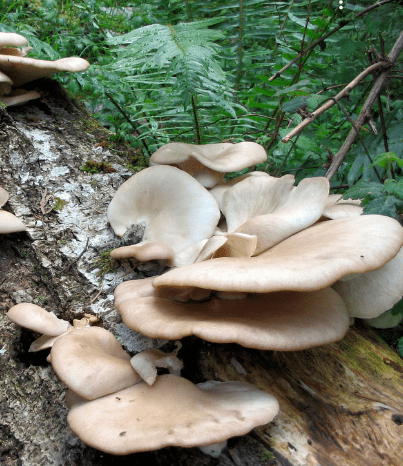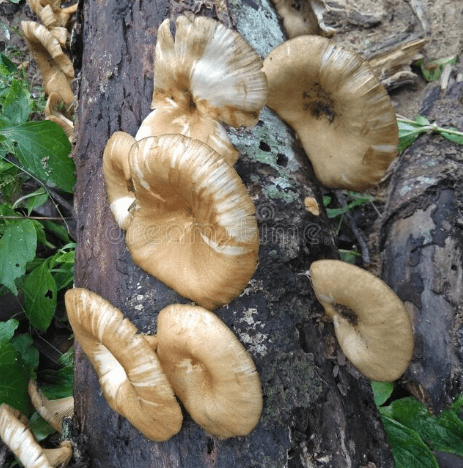Although they are fungi, mushrooms can live in a variety of settings. Not all mushrooms can. Some mushrooms can even grow on wood, while others only grow in moist, shaded areas.

A damp climate will allow mushrooms to grow on wood. Mushrooms are encouraged to feed on the lignin (wood fibers) and thrive as a result of moisture in the wood causing the fibers to decay and perish. Mushrooms can grow on wood, but they do so in quite different ways for dangerous and edible species.
Almost anyplace there is moisture and a decent food source, mushrooms can grow.
You will have a better understanding of mushrooms after reading this article. You will also learn why they grow on wood and what you can do to stop them from growing in unwelcome places.
Table of Contents
What Types of Mushrooms Grow on Wood?
Mushrooms typically favor dead, wet, and rotting wood for growth. Mushroom conks are fungi’s reproductive organs.
The growth of mushroom conks on a tree’s trunk is a sign of internal decay.
The environment plays a major role in the development of mushrooms. It is possible to cultivate both edible and therapeutic mushrooms on wood. I’ll give you a few instances:
Oyster Mushroom:
The oyster mushroom (Pleurotus ostreatus) is a type of edible fungus that resembles an oyster in appearance and flavor.
They develop spontaneously on trees. However, they are also cultivated commercially on materials like straw or coffee grounds.
They can be gathered from logs in the fall of the year following their inoculation because of their quick incubation period.
They have a high nutritional value and are typically found on dead hardwoods like beech and oak trees.
Lion’s Mane:
The white teeth or needles on this fungus, Hericium Erinaceus, which give it a shaggy appearance, gave it the moniker “Lion Mane.”
They thrive on a variety of woods, including poplar, beech, and maple. The ripe mushrooms have a diameter of 40 cm.
These mushrooms are generated by mycelium during the spring and fall seasons. Although they can be eaten, they are also useful in medicine.
Sulphur Shelf Mushroom:
The chicken mushroom, or sulfur shelf mushroom (Laetiporus Sulphureus), is a brilliant yellow or orange mushroom with a pronounced meaty flavor.
They often form shelf-like clusters and are found on huge oak trees. They appear to have 2–12 inch wide, nearly 8-inch deep semicircular crowns.
On the base of their caps, there are very little pores. These mushrooms contain a variety of plant substances, including polysaccharides, cinnamic acid, and eburicoic acid.
They harvest during the summer and fall seasons.
Mushrooms Growing on Wood

Water or moisture tends to speed up the deterioration process, increasing the likelihood of moss and fungal growth, which results in mushrooms sprouting in wooden housing structures.
Due to spores that were embedded in the potting soil or the mulch media that was utilized, excessive moisture will cause mushrooms to grow in vegetable gardens and potted plants.
Mushrooms in the Home
When the conditions are right, mushrooms can grow in nearly any area. They may spread through air or water droplets, and their spores are essentially everywhere. They may enter the house in this manner.
When mushrooms appear on wooden housing structures, it indicates that the building is continuously exposed to dampness.
Wooden fixtures and bathroom doors are two typical locations for the growth of moss, spores, and mushrooms.
Another location is in the wooden fixtures and moldings throughout the house.
Stopping the source of moisture in its tracks is the most effective technique to prevent mushrooms and their spores from developing on hardwood furniture.
In order to prevent steam odors from accumulating on the wooden furniture, this can include turning off the humidifier or opening the windows.
Mushrooms Growing Outdoors
A garden can really benefit from mushrooms. The fungi aid in the transformation of mulch, wood chips, and other complex organic material in the garden into plant nutrition.
The presence of bacteria and fungi indicates a healthy soil.
They are helpful fungi that support plant growth by forming a symbiotic relationship with plants. Soil with mushrooms is an indicator of a small yet healthy ecosystem.
They prefer to grow on wood because they may consume the organic material produced as the wood decays. They break down lignin and get nutrients from the wood substrate.
On, mushrooms will develop:
- Trees
- Expired Leaves
- Turf grass
- Logs
- Mulch
Plants protect one another and the mushroom colony in addition to converting nutrients into something the mushrooms can use.
This occurs so that nearby plants may strengthen their defenses when others are being attacked. Mushrooms and fungi act as a network of communication between the plants in the soil and give them a way to send each other distress signals during insect attacks.
Can You Eat Mushrooms that Grow on Logs?
Although they are not considered to be plants and are instead a member of the Fungi plant kingdom, mushrooms are categorized as vegetables.
The majority of mushrooms are also regarded a vegan dietary source and are an excellent source of selenium and potassium. They also include significant amounts of fiber, protein, and antioxidants while being low in calories.
The topic at hand is whether or not these mushrooms that grow on wood are edible. The answer is actually fairly straightforward; depending on the species of mushroom, some of them are edible and others are not.
You should be warned that many mushrooms are toxic, and even a small amount of them can make you sick.
Oyster mushrooms, shiitakes, chicken of the woods, wine caps, chanterelles, pioppini, nameko, and lion’s mane are a few edible species of wood-growing mushrooms.
One of the edible mushrooms, reishi, has important health advantages and may grow on wood.
However, due to their small size or unappealing flavor, several of these mushrooms are either not known to be edible or are not chosen for consumption.
Avoid conducting tests with their eating in the event that you are unable to determine if they are poisonous or not.
How to Prevent Mushrooms from Growing on Wood?
You may now be asking how to remove mushrooms from wood.
Mushrooms are fruiting bodies of mycelium, which are undetectable microscopic organisms.
In order to remove mushrooms, you must address the mycelium, which is challenging because of how quickly it multiplies.
It does not appear feasible to destroy mycelium. However, there are a number of strategies to stop them from developing on wood, including:
- You may get rid of mushrooms by simply picking them. Pull them with a gloved hand if you are unsure about the type.
- Second, you can kill any visible mushrooms by misting them with a solution made of 1 part white vinegar to 4 parts water. Waiting for the degradation of dried mushrooms is an option.
- Lime is also helpful since it will sweeten the surface to get rid of mushrooms, which need an acidic environment to develop.
- Spraying them with a commercial fungicide that may harm their mycelium is a third option.
Can You Use Wood to Grow Mushrooms?
Mushrooms can be grown on wood. That sounds intriguing. Well, the concept of growing mushrooms on logs originated in Asia 2000 years ago, but it is now being used professionally in the West.
Selecting healthy trees is essential for mushroom growth because sick wood already has fungus that can enhance competition odds.
Larger logs are better for their growth because it takes more time for the mycelium to colonize a longer log and begin generating mushrooms.
Some fundamental procedures for growing mushrooms on wood include:
- Get tools and mushroom spawn.
- Logs are cut for inoculation.
- – King Oyster Mushroom.Whether these mushrooms can grow on wood is the topic at hand. Well, the answer is fairly straightforward; depending on the species of mushroom, some of them are edible and others are not.
- A lot of mushrooms are dangerous, so exercise caution when eating any of them.
- Among the edible species of wood-growing mushrooms are oyster mushrooms, shiitakes, chicken of the woods, wine caps, chanterelles, pioppini, nameko, and lion’s mane.
- Reishis is a type of edible mushroom that grows on wood and has important health advantages.
- But some of these mushrooms may not be edible, or people may not like eating them because of their small size or unappealing flavor.
Benefits of Mushrooms Cultivation on Logs:
Stay away from doing experiments involving their eating if you can’t tell whether they are toxic or not.
- You might be asking how to get mushrooms off of wood at this point.
- Mushrooms are actually mycelium fruiting bodies, which are microscopic organisms that are hidden.
- Because they grow so quickly, mycelium must also be dealt with in order to remove mushrooms, which is a challenging task.
